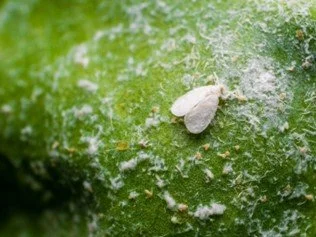WHITEFLIES
Whiteflies are small, white flies from the family Aleyrodidae, that cluster in large numbers on the bottom sides of leaves and fly around the plants when disturbed. They feed by sucking sap from the plant and heavy infestations can cause plants to shed leaves. They also excrete honeydew and can cause black sooty mold. Adult whiteflies will lay eggs on the bottoms of leaves which will hatch in three to seven days. The nymphs are responsible for most of the damage.
Non pesticide options:
Vacuum – You can knock down the number of adult whiteflies quickly by using the hose on a vacuum to catch them. Don’t try to vacuum them directly off of the plants but they’re easy to catch since they just fly right around the plants when disturbed
Horticultural oil – This is a mechanical pesticide. It kills whiteflies by suffocating them and is only active on the nymph stage. It does not kill eggs or adults. It requires direct contact and has no residual action
Horticultural oil and other oil-based pesticides can damage leaves. They can cause burning or other damage if applied when temperatures are high (80-85F or higher) or if the leaves are sensitive. Always test it on a couple leaves first before spraying a whole plant.
Horticultural oil can also be mixed with many other pesticides to increase their effectiveness
Insecticidal soap – Kills nymphs on contact but has no residual effect
Yellow sticky traps – Adult whiteflies are attracted to yellow sticky traps. These can reduce the populations somewhat but they are more of an early warning system.
Insecticides
Spirotetramat — is the latest generation miticide and insecticide, offering broad systemic protection against spider mites, thrips, scale, mealybugs and more. Given its recent entrance to the market it works exceptionally well against mites that have developed resistance to other more common miticides. It is active on eggs, larvae, and nymphs and adults. Unlike any other miticide it works systemically, and is absorbed from the soil up to the leaves, as well as from leaf to leaf, and will provide resistance for up yo 30-45 days.
Bifenthrin – Bifenthrin – a synthetic pyrethroid with a broad range of controlled pests including termites and spiders. Pyrethroid pesticides are excellent for controlling adult whiteflies. One of my favorites, bifenthrin is effective at controlling most common pests and even suppresses spider mites. In addition to plant applications it makes a good barrier spray for around the home. It is inexpensive too, you can buy it as Bifen I/T in a 16oz bottle for about $22
Permethrin – another synthetic pyrethroid with a smaller range of controlled pests. It is the active ingredient in dog flea collars and human lice medicine but it is a neurotoxin to cats so if you have cats keep them away from treated areas until dry (~12 hr). It can be found at home depot or lowes under the brand name Bonide eight in a 32oz container for about $20
Azadirachtin – Azadirachtin is a limonoid chemical derived from neem seeds that acts as an antifeedant and insect growth regulator (IGR). It is significantly more effective as a pesticide than cold pressed neem oil. Since it is oil based it should be applied early morning or late evening to avoid burning leaves, plus it is safe for pollinators once dried. It has a short-term residual effect. It is effective on both adult and larval stages of whitefly.
Azadirachtin is sold in the US under the brand name Azamax from General Hydroponics. You can find it on amazon in a 4oz bottle for about $25
Imidacloprid – Imidacloprid is a systemic neonicotinoid that kills everything except for spider mites and hard scale. It is the most extremely effective against whiteflies but since it’s a systemic it takes some time to start working and is best used as a preventative or in conjunction with a knockdown pesticide. It is available in granular form that is applied to the soil and provides protection for 90 days. I highly recommend this for all indoor plants. See “Imidacloprid” in the mealybug section for more information

